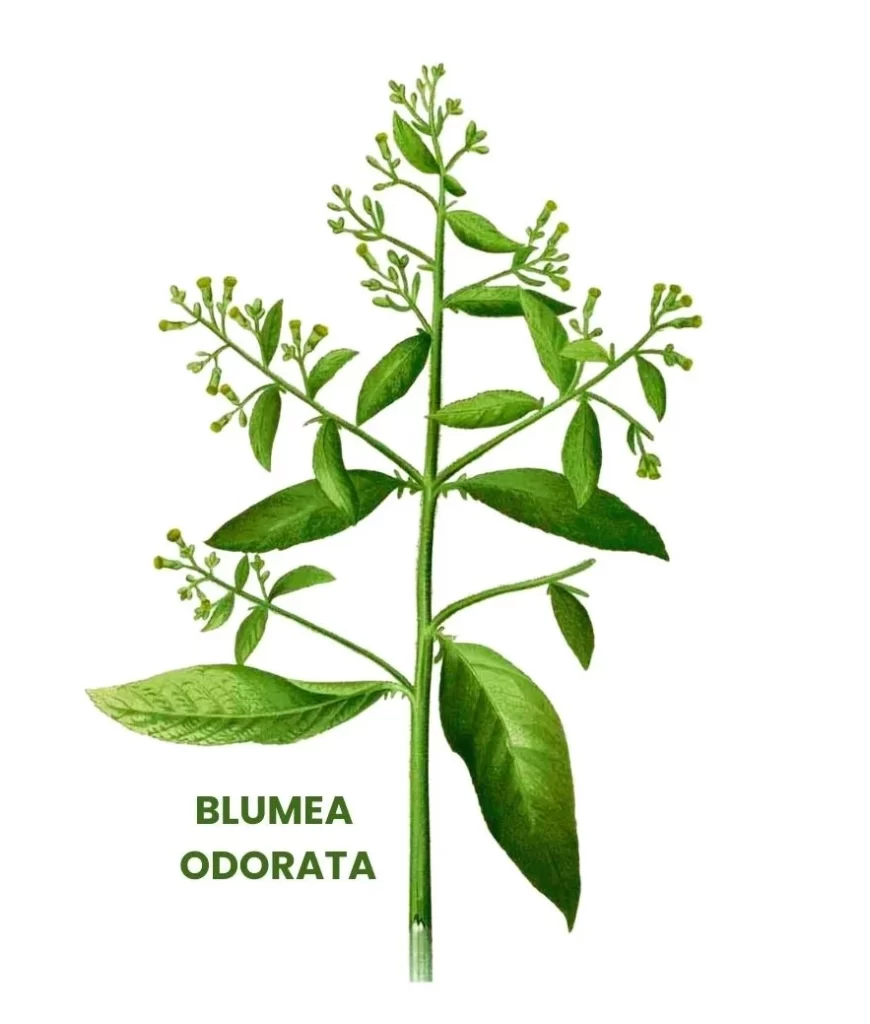Blumea odorata (Kuksima), also known as Kukundar or Kukurmota, is a medicinal plant belonging to the family Compositae.
It is renowned for its therapeutic properties in treating various ailments, including cough, fever, haemorrhage, and hoarseness.

Table of Contents
ToggleSOURCE INFORMATION
Scientific Classification
- Kingdom: Plantae
- Family: Compositae
- Genus: Blumea
- Species: Blumea odorata
Origin and Historical Facts
- Blumea odorata is native to tropical and subtropical regions of Asia, particularly found in countries like India, Bangladesh, and Myanmar.
- In traditional medicine systems like Ayurveda, it has been used for centuries to address respiratory issues, fever, and hemorrhages.
- Indigenous communities have valued Blumea odorata for its medicinal properties and have incorporated it into various herbal remedies.
Usage in Medicine
- Blumea odorata has a long history of medicinal use, particularly in treating cough, fever, hemorrhages, and hoarseness.
- It is employed as a remedy for various respiratory conditions, including cough-hoarseness, characterized by distinct sounds like trumpet or barking.
- Additionally, it is effective in reducing fever, especially in cases of tertian fever.
- The plant is renowned for its ability to stop hemorrhages, addressing conditions such as bleeding piles, bloody diarrhea, profuse hemorrhages in miscarriage, and menorrhagia.
Cultural Significance
- Blumea odorata holds cultural significance in traditional medicine practices across Asia, where it has been utilized for generations to promote health and wellness.
- Its widespread use in indigenous healing traditions underscores its importance as a therapeutic agent in local communities.
Modern Applications
- Today, Blumea odorata continues to be used in herbal medicine and homeopathy, with its extracts and tinctures employed for various health conditions, particularly those related to the respiratory and circulatory systems.
DRUG PATHOGENESIS
- Blumea odorata acts on the respiratory system, circulatory system, and mucous membranes.
- It helps in controlling cough, reducing fever, stopping haemorrhage, and relieving hoarseness.
KEY CHARACTERISTICS
- Effective in controlling cough, especially cough-hoarseness.
- Useful in managing fever, particularly in tertian fever cases.
- Exhibits a powerful influence in stopping haemorrhage, including bleeding piles, bloody diarrhea or dysentery, profuse hemorrhages in miscarriage, and menorrhagia.
- Alleviates hoarseness associated with cough, characterized by trumpet-like or barking-like sounds.
DETAILED ORGAN SYMPTOMS
- Cough: Blumea odorata is indicated for cough accompanied by hoarseness, characterized by distinct sounds like trumpet or barking. It effectively suppresses cough and provides relief.
- Fever: It is beneficial in tertian fever cases, helping to reduce body temperature and alleviate associated symptoms.
- haemorrhage: Blumea odorata is highly effective in stopping various forms of haemorrhage, including bleeding piles, bloody diarrhea or dysentery, profuse haemorrhage in miscarriage, bloody leucorrhoea, and menorrhagia.
DOSE
- Blumea odorata is commonly administered in the form of mother tincture, 2x, or 3x potency.
Frequently Asked Questions
What is Blumea odorata used for?
- Blumea odorata is used to treat cough, fever, haemorrhage, and hoarseness.
What potencies are commonly used for Blumea odorata?
- Mother tincture, 2x, and 3x potencies are commonly used.
Is Blumea odorata effective for stopping haemorrhage?
- Yes, it is highly effective in stopping various forms of haemorrhage, including bleeding piles, bloody diarrhea, profuse haemorrhage in miscarriage, and menorrhagia.
Meaning of Difficult Words
- Tertian fever: A type of malaria characterized by fever recurring every two days.
- Hoarseness: A condition where the voice becomes rough or raspy, often accompanied by difficulty in speaking due to irritation or inflammation of the vocal cords.
